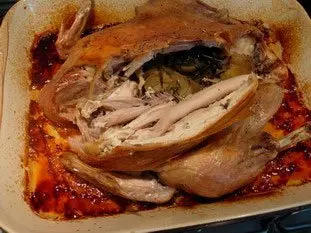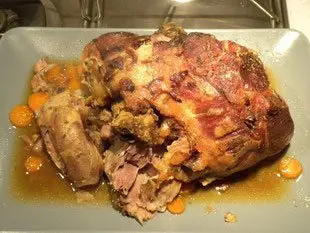In praise of slow cooking

You will no doubt have noticed that in cookery, it's often the actual cooking process that gets neglected. This is understandable; it comes at the end of the recipe and getting the dish in the oven is something of a relief (ah, that's done!), which frees us to cope with what's left: tidying the scene of the action, doing the washing up.. or starting on another recipe.
42 K 4.2/5 (21 reviews)
Last modified on: February 9th 2011
In praise of slow cooking
For a lot of dishes, whether they're cooked fast or slow, hotter or cooler, doesn't really matter. Take a cake for example, as long as it's not actually burnt, when it's done, it's done and it needs to come out of the oven otherwise it will start to dry out and harden, then burn.
But for plenty of other dishes, and especially those containing vegetables or meat, it's possible to use another style of cooking, known as “slow cooking” or “low temperature cooking” .
The principal is as simple a it gets: we turn down the heat and increase the length of cooking time accordingly. The cooking time is therefore much longer, but as the temperature is so much lower than normal, the dish doesn't burn.
This is not a recent discovery of molecular cuisine or the like, it's a principal as old as the hills which we're only now rediscovering.
With this long, slow cooking – and it is real cooking – the ingredients are not shocked by the oven temperature, but gently brought up to the right temperature. A renowned dish of French cuisine which uses this method is the famous “seven-hour lamb” (leg of lamb).
This has two major consequences:
1) The food doesn't dry out. This applies to meat in particular, which stays tender and develops a melting texture (you can break it apart with a fork).
2) Flavours are enhanced, as the process favours the famous Maillard reactions.
So, in short, there is everything to be gained, the only drawback being the extra time required for dishes to be properly cooked, which may not always be available.
One concrete example: to roast a chicken by the conventional method, the oven is normally set to 220°C (430°F) for about 45 minutes. The result is a roasted, browned chicken that's already rather good.
For slow cooking, the same chicken can be put in the oven at 140°C (280°F) for 5 hours, and the result is a roast chicken with an amazing flavour and so tender that it can be eaten simply with a fork; the meat just falls off the bones, even on the drumsticks.
It's five hours poultry.
The same process can be prolonged even further by putting the same chicken in a cooking bag with vegetables and whatever herbs you choose into the oven at 100°C (210°F) for 12 hours. You'll be surprised at the result.
To round up, don't forget that slow cooking is more of a method than a recipe, so the temperature and time are not necessarily exact. You just need to keep the temperature below 150°C (300°F) and above 80°C (180°F), then alter the cooking time depending on the result you wish to achieve, but with a minimum of 2 hours. The simple rule is this: the lower the temperature, the longer the cooking time needs to be.
One tip, even so : if you want to slow cook a piece of red meat, it will look much more appetising if you seal it on each side for one minute in a little really hot oil, and only then put it on to cook slowly.
But for plenty of other dishes, and especially those containing vegetables or meat, it's possible to use another style of cooking, known as “slow cooking” or “low temperature cooking” .
The principal is as simple a it gets: we turn down the heat and increase the length of cooking time accordingly. The cooking time is therefore much longer, but as the temperature is so much lower than normal, the dish doesn't burn.
This is not a recent discovery of molecular cuisine or the like, it's a principal as old as the hills which we're only now rediscovering.
With this long, slow cooking – and it is real cooking – the ingredients are not shocked by the oven temperature, but gently brought up to the right temperature. A renowned dish of French cuisine which uses this method is the famous “seven-hour lamb” (leg of lamb).

This has two major consequences:
1) The food doesn't dry out. This applies to meat in particular, which stays tender and develops a melting texture (you can break it apart with a fork).
2) Flavours are enhanced, as the process favours the famous Maillard reactions.
So, in short, there is everything to be gained, the only drawback being the extra time required for dishes to be properly cooked, which may not always be available.
One concrete example: to roast a chicken by the conventional method, the oven is normally set to 220°C (430°F) for about 45 minutes. The result is a roasted, browned chicken that's already rather good.
For slow cooking, the same chicken can be put in the oven at 140°C (280°F) for 5 hours, and the result is a roast chicken with an amazing flavour and so tender that it can be eaten simply with a fork; the meat just falls off the bones, even on the drumsticks.
It's five hours poultry.

The same process can be prolonged even further by putting the same chicken in a cooking bag with vegetables and whatever herbs you choose into the oven at 100°C (210°F) for 12 hours. You'll be surprised at the result.
To round up, don't forget that slow cooking is more of a method than a recipe, so the temperature and time are not necessarily exact. You just need to keep the temperature below 150°C (300°F) and above 80°C (180°F), then alter the cooking time depending on the result you wish to achieve, but with a minimum of 2 hours. The simple rule is this: the lower the temperature, the longer the cooking time needs to be.
One tip, even so : if you want to slow cook a piece of red meat, it will look much more appetising if you seal it on each side for one minute in a little really hot oil, and only then put it on to cook slowly.
Lasts posts
Butter vs. grease
We often read in a recipe where a pastry is put into a mould that, just before pouring, the mould should be buttered or greased. But what's the difference between these 2 terms?December 1st 20251,2395
Getting out of the fridge early
Very often when you're cooking, you need to take food or preparations out of the fridge, to use them in the recipe in progress. There's nothing tricky about this: you just take them out of the fridge and use them, usually immediately, in the recipe. But is this really a good method?November 24th 20251,2195
Who's making the croissants?
When you look at a bakery from the outside, you naturally think that in the bakery, the bakers make the bread, and in the laboratory, the pastry chefs make the cakes. It's very often like that, with each of these professions having quite different ways of working, but sometimes there's also one...November 23th 20251,108
Oven height
When we put a dish or cake in the oven, we naturally tend to put it on the middle shelf, and that's what we usually do. But in some cases, this position and height can be a little tricky, so let's find out why.October 8th 20253,0395
The importance of sieving
In recipes that use a fine powder (flour, powdered sugar, etc.), you'll often see the advice to sift before using it. To sift is to pass the powder in question through a sieve (a very fine strainer) before incorporating it into your recipe. It's often advice, but is it really useful?September 3rd 20257,7303
Other pages you may also like
Baking cakes
Where we see that to put a cake in the oven, once the dough is finished and in its mould, there is no hurry and that the cold is your friend.June 28th 201945 K4.1
Different kinds of pastry and dough
When cooking in general, and particularly in baking, we can make and use many different kinds of pastry and dough. All built on the same "base": flour - a powder to which we add fat, liquid or both to produce the dough which is then cooked. .November 6th 2012111 K 14.0
The art of the charlotte
In cooking, a charlotte is a delicious moulded dessert, with biscuits around the outside that have been soaked in a flavoured syrup, filled with a light cream or mousse. The charlotte is left to set in the fridge before being turned out and served in slices. It is very light and a lovely sweet...February 27th 201346 K4.3
Raising (or leavening) agents
When we want to make a dough or batter rise when baking, either in patisserie or bread-making, we need to use a raising agent or leavening agent, one of which is called leaven. In the context of baking, a raising agent is simply what "makes something rise". It is a substance which, when added to...June 16th 202157 K4.8
Artichoke stalks
When preparing artichokes for cooking, you may well already know that we often need to remove the first round of leaves, if they are tatty or dirty, as well as the inedible stalk. The operative word here is “remove” , rather than “cut off”.October 25th 201653 K4.3
Post a comment or question
Follow this page
If you are interested in this page, you can "follow" it, by entering your email address here. You will then receive a notification immediately each time the page is modified or a new comment is added. Please note that you will need to confirm this following.
Note: We'll never share your e-mail address with anyone else.
Alternatively: you can subscribe to the mailing list of cooling-ez.com , you will receive a e-mail for each new recipe published on the site.









